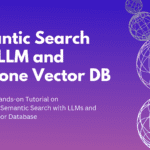In today’s rapidly evolving digital landscape, the need for efficient information retrieval has become paramount. Traditional keyword-based search engines, while still widely used, often fall short in understanding the nuanced intent behind user queries. Enter vector search with LLMs (Large Language Models), a revolutionary approach that combines the power of vector representations with advanced language understanding capabilities. In this article, we’ll delve into the intricacies of vector search, explore its synergy with LLMs, and illustrate its real-world applications.
Understanding Vector Search
Vector search revolves around the concept of representing data points—such as text documents, images, or even code snippets—as numerical vectors in a high-dimensional space. These vectors encapsulate the essence of the data, including its semantic meaning and relationships with other data points. Unlike traditional keyword-based search, which relies on exact matches, vector search focuses on identifying similarities between vectors to retrieve relevant information.
How Does Vector Search Work?
- Data Embeddings: Vectorization begins by transforming data points into numerical representations, known as embeddings. These embeddings are derived using techniques like word embeddings or pre-trained language models, which capture semantic relationships between words, phrases, or even visual features.
- Vector Indexing: Once data points are represented as vectors, they are stored in a specialized database, often referred to as a vector search engine. This engine is optimized for efficiently searching and retrieving similar vectors based on predefined distance metrics, such as cosine similarity.
- Matching and Retrieval: When a user submits a query, it is converted into a query vector using the same embedding techniques. The vector search engine then compares this query vector with the vector representations of database items to identify the most similar vectors, thereby retrieving relevant information.
Real-world Examples of Vector Search
- Document Retrieval: Vector search can be used to retrieve documents similar to a given text query, enabling more comprehensive search results beyond exact keyword matches.
- Image Similarity Search: In the realm of image search, vector representations allow for the retrieval of visually similar images based on their content, rather than relying solely on metadata or file names.
Vector Search with LLMs (Large Language Models)
Large Language Models (LLMs) represent a breakthrough in natural language processing, capable of understanding and generating human-like text at scale. These models, trained on vast amounts of textual data, possess a deep understanding of language semantics and syntax.
Synergy between Vector Search and LLMs
- Semantic Understanding: LLMs enhance vector search by providing contextual understanding to queries. By analyzing the intent and meaning behind user queries, LLMs help refine search results, ensuring they align with user expectations.
- Knowledge Integration: While LLMs excel in language understanding, they often lack access to structured knowledge bases. Vector search bridges this gap by providing access to structured information through vectorized representations, enabling LLMs to retrieve factual and contextualized data.
Performing Vector Search with LLMs
- Query Processing: When a user submits a query, the LLM first processes it to understand its semantics and context. This involves breaking down the query into concepts, synonyms, and related topics.
- Leveraging Vector Search: Armed with an understanding of the query, the LLM interacts with the vector search engine, providing the query vector or relevant concept vectors.
- Semantic Retrieval: The vector search engine retrieves data points with vectors closest to the query vector, ensuring semantically similar information is prioritized over keyword matches.
- Response Generation: Finally, the LLM receives the retrieved data points and generates a comprehensive response by leveraging its vast knowledge and language understanding capabilities.
Real-world Applications
1. Enhanced Search Engines: Example: Consider searching for “healthy recipes.” Vector search, powered by LLMs, can retrieve recipes similar to those previously enjoyed by the user, even if they don’t contain the exact keyword “healthy.” The LLM can further analyze these recipes, highlighting their nutritional value or suggesting dietary substitutions.
2. Intelligent Chatbots: Customer service chatbots, equipped with vector search and LLMs, can provide more relevant responses by retrieving information from a knowledge base of product manuals and FAQs. This ensures personalized assistance tailored to the user’s specific query or issue.
3. Personalized Recommendations: Recommendation systems can leverage vector search with LLMs to offer personalized suggestions based on user behavior, preferences, and context. For instance, a music streaming service can recommend songs based on the emotional tone or musical style of the user’s favorite tracks.
4. Academic Research Discovery: Researchers exploring a specific topic can benefit from vector search with LLMs. By inputting a research question or topic, LLMs can retrieve relevant academic papers or articles from databases. Vector search ensures that retrieved documents are not only keyword matches but also semantically aligned with the researcher’s inquiry, facilitating more efficient literature review and knowledge discovery.
5. E-commerce Product Search Enhancement: In e-commerce platforms, vector search with LLMs can revolutionize product discovery. Instead of relying solely on product titles or descriptions, users can input natural language queries describing what they seek. The LLM, supported by vector search, can then retrieve products that closely match the user’s preferences, leading to a more intuitive and personalized shopping experience.
Final Words
In conclusion, the fusion of vector search with LLMs represents a paradigm shift in information retrieval and AI-driven applications. By combining the semantic understanding of LLMs with the efficiency of vector search, developers can unlock new possibilities for enhancing search engines, chatbots, recommendation systems, and more, ultimately providing users with more intelligent and personalized experiences.



